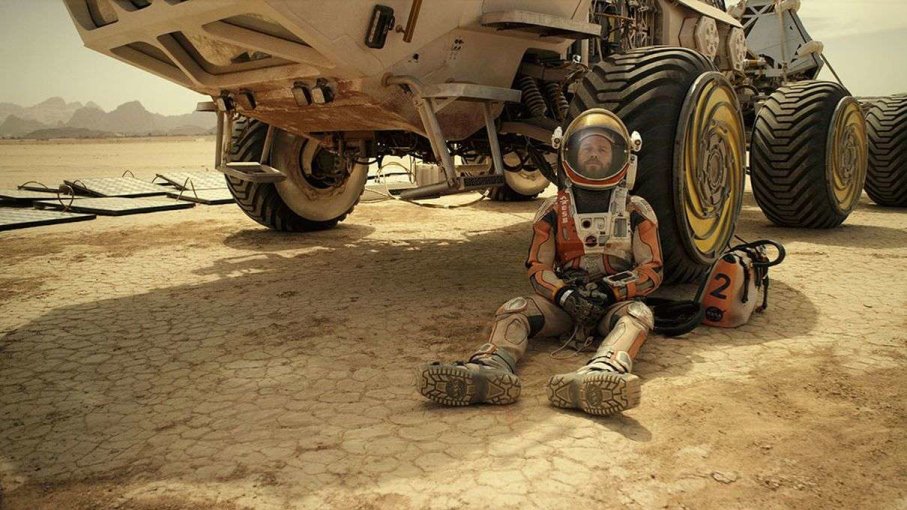Spacesuit Punctured? No Problem. NASA’s Working on Self-Repairing Suits

In the book and hit movie “The Martian,” astronaut Mark Watney is knocked for a loop by a Red Planet dust storm and separated from the rest of the crew. One of his first survival challenges is to quickly patch a hole in his space suit with a kit that he carries for just that sort of emergency.
In real life, spacesuit punctures are a danger that’s long concerned NASA, since astronauts on spacewalks are vulnerable to being hit by tiny pieces of space junk or micro-meteors. If that happened, you might guess that an astronaut simply could hold his or her breath, the way you could underwater. But guess again.
As this Scientific American article explains, the human body is accustomed to having atmospheric pressure to keep itself intact and in working order, and if it were subjected suddenly to the vacuum of space, all kinds of bad stuff would start to happen. Air already in the astronaut’s lungs would expand, tearing the delicate tissues that enable gas exchange with the bloodstream. Water in the body’s tissues would vaporize, and cause the astronaut to swell up grotesquely, like an over-inflated toy balloon. Water and gas in the blood would form bubbles in the astronaut’s veins, and after a minute, circulation would stop. Without oxygen going to the brain, the astronaut would pass out, and animal tests indicate that after about two minutes, the astronaut would be dead.
That’s why NASA has been trying for a while to develop an alternative to the conventional pressurized spacesuit, which uses tight-fitting materials rather than gas to protect a space traveler in emergencies. But now the space agency and a team of University of Michigan researchers may have come up with an even better answer — a new plastic that, when penetrated, instantly fixes the hole by itself.
Imagine the way that the T-1000 (portrayed by actor Robert Patrick) patches bullet holes in the sci-fi thriller “Terminator 2: Judgement Day,” and you’ll get the general idea — except that the new material fixes itself far more quickly than the robotic assassin did.
Pause
Unmute
Remaining Time -3:37
Picture-in-Picture
Fullscreen
The breakthrough — or rather, breakthrough prevention — technology is described in a recent article in the scientific journal ACS Macro Letters. It was developed by a team that included University of Michigan assistant professor of chemical engineering Timothy Scott and Ph.D candidate and NASA Space Technology Research Fellow Scott Zavada, the study’s lead author.
Just as the fictional Mark Watney in “The Martian” did, the researchers wanted to patch space suits with a plastic resin that would harden quickly. But instead of having an astronaut carry a resin kit, they put the resin between two layers of the plastic material from which the spacesuit would be made. They picked a resin called thiol-ene-trialkylborane, which when exposed to oxygen, reacts to form a solid substance. The idea is that in the event of a spacesuit puncture, the air rushing out of the suit would be the catalyst for the repair reaction.
“Our approach permits the development of materials capable of sealing a breach within seconds, far faster than previously described methods,” the researchers wrote.
In order to test the material’s ability to patch itself, the researchers took it to a gun range and used a bolt-action rifle to fire a bullet through it from 36 feet away. Check out this video from the American Chemical Society showing what happened.
Next, NASA will test the material in a vacuum and simulated low gravity conditions at the agency’s Glenn Research Center in Cleveland, Ohio, to get sense of how it well it would repair itself in space. The material also might end up in spaceships and the exterior of the base that astronauts eventually may build on Mars.
N



 Creators of mankind
Creators of mankind Description of “Tall white aliens”
Description of “Tall white aliens” Where they came from?
Where they came from? About hostile civilizations
About hostile civilizations The war for the Earth
The war for the Earth “Tall white aliens” about eternal life
“Tall white aliens” about eternal life Video: “Nordic aliens”
Video: “Nordic aliens” Aliens
Aliens Alien encounters
Alien encounters The aliens base
The aliens base UFO
UFO Technology UFO
Technology UFO Underground civilization
Underground civilization Ancient alien artifacts
Ancient alien artifacts Military and UFO
Military and UFO Mysteries and hypotheses
Mysteries and hypotheses Scientific facts
Scientific facts


















